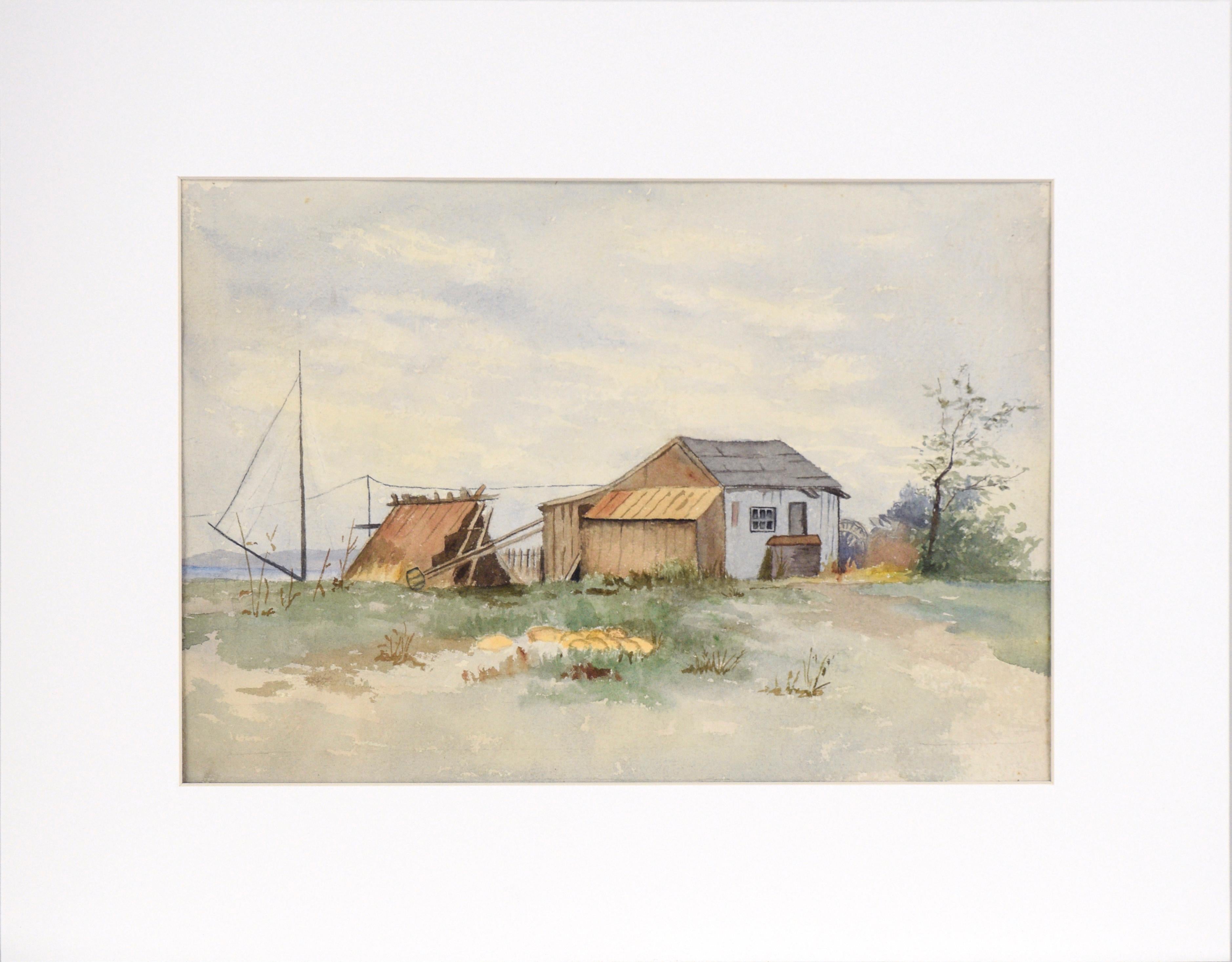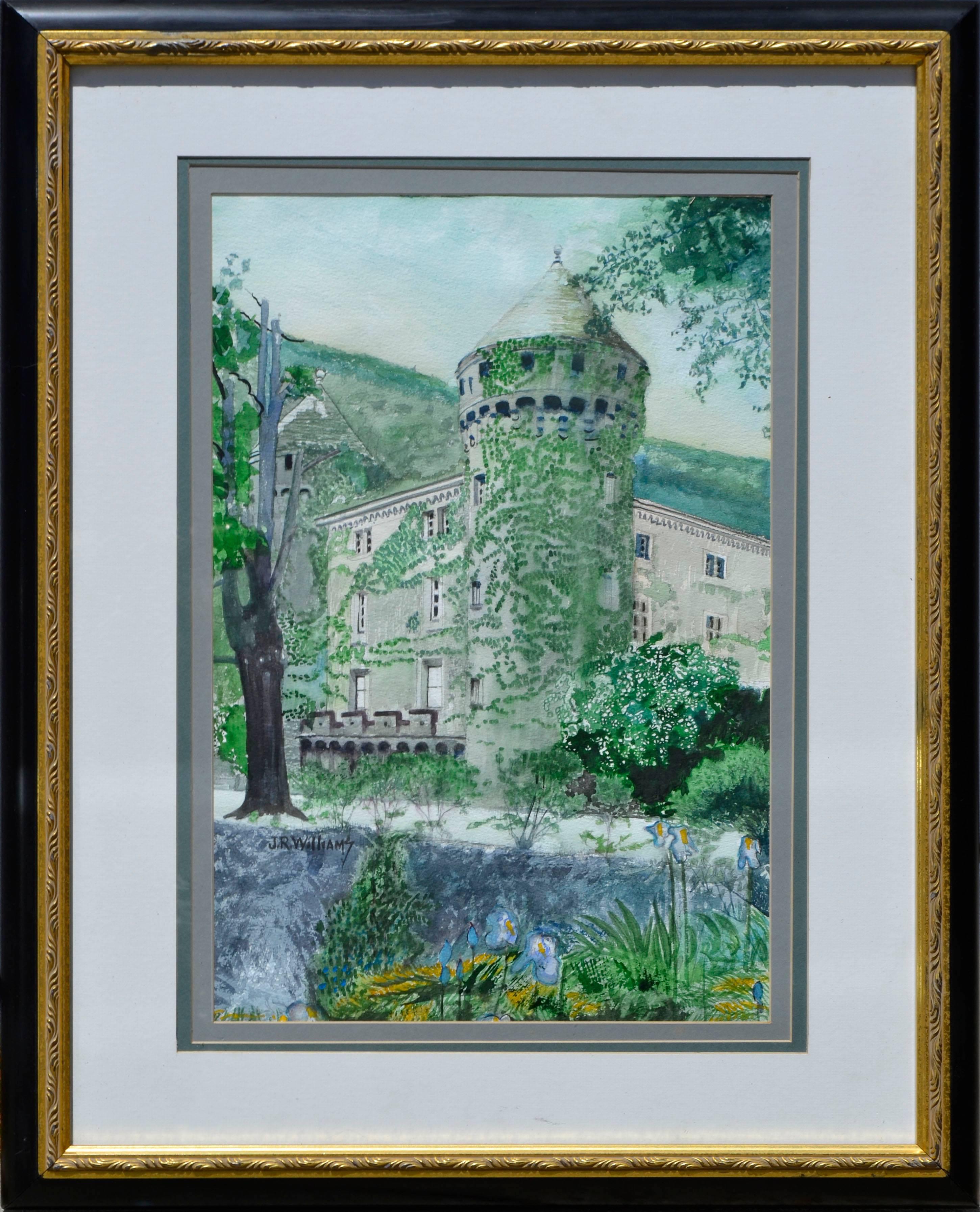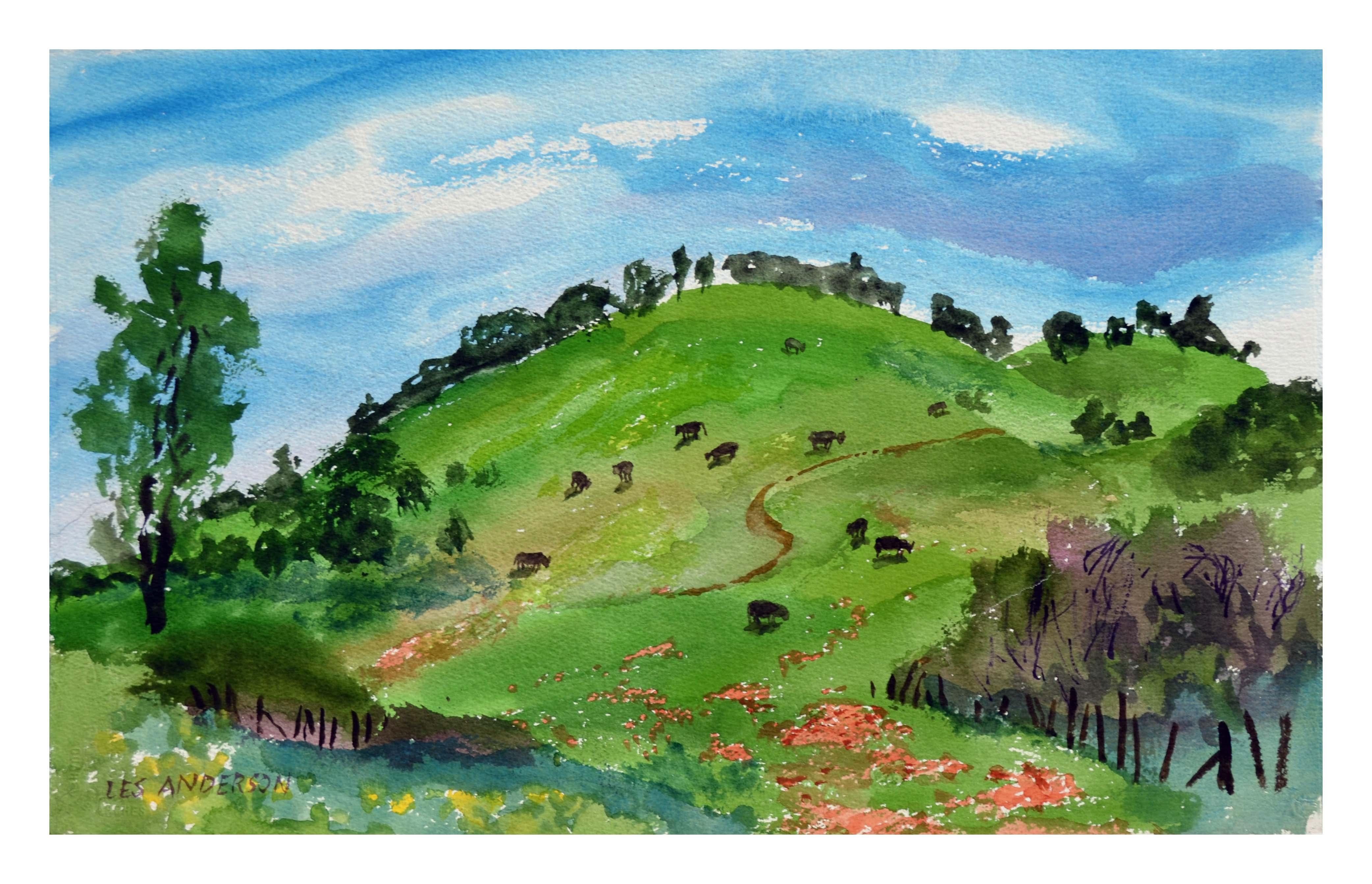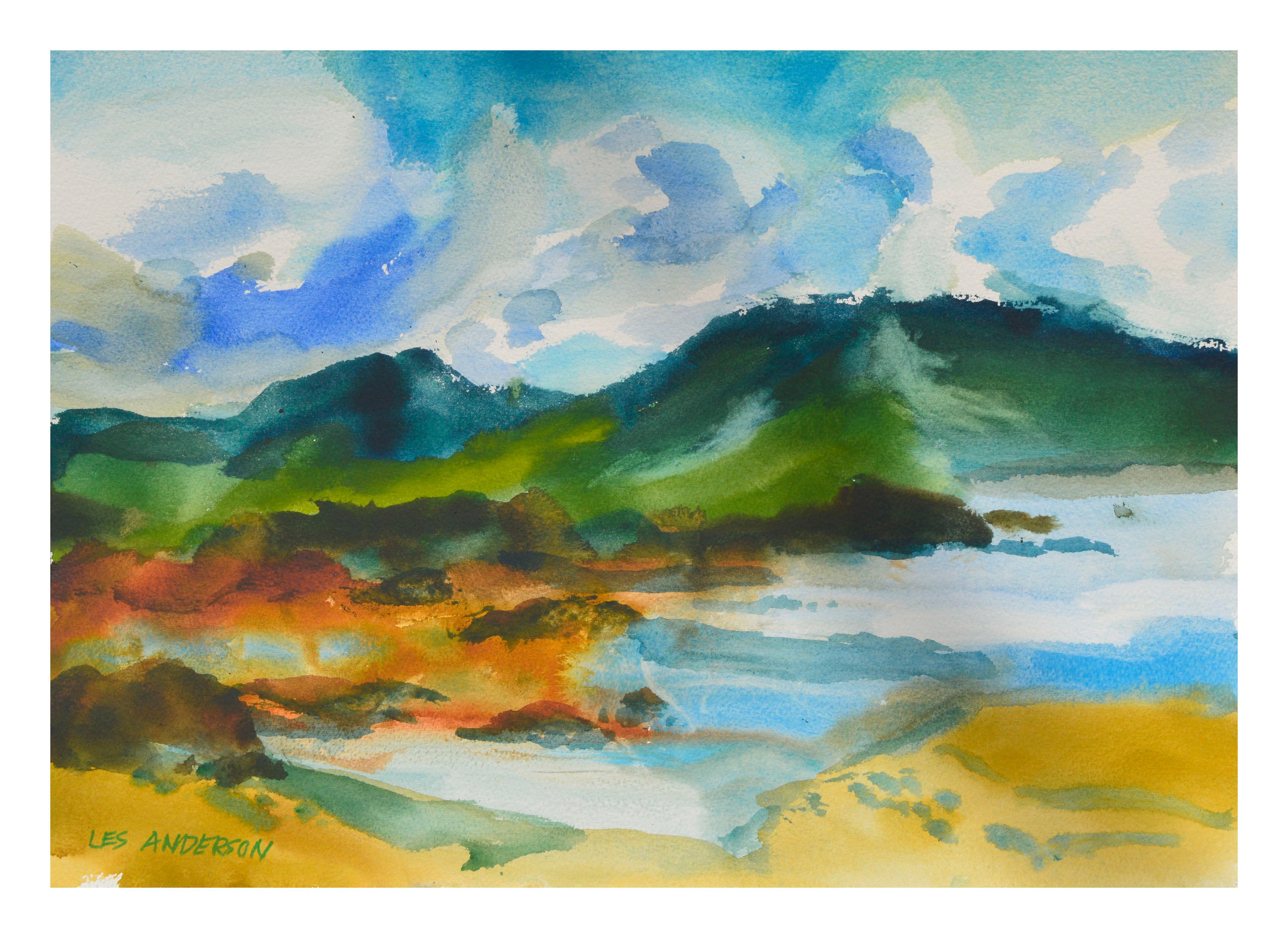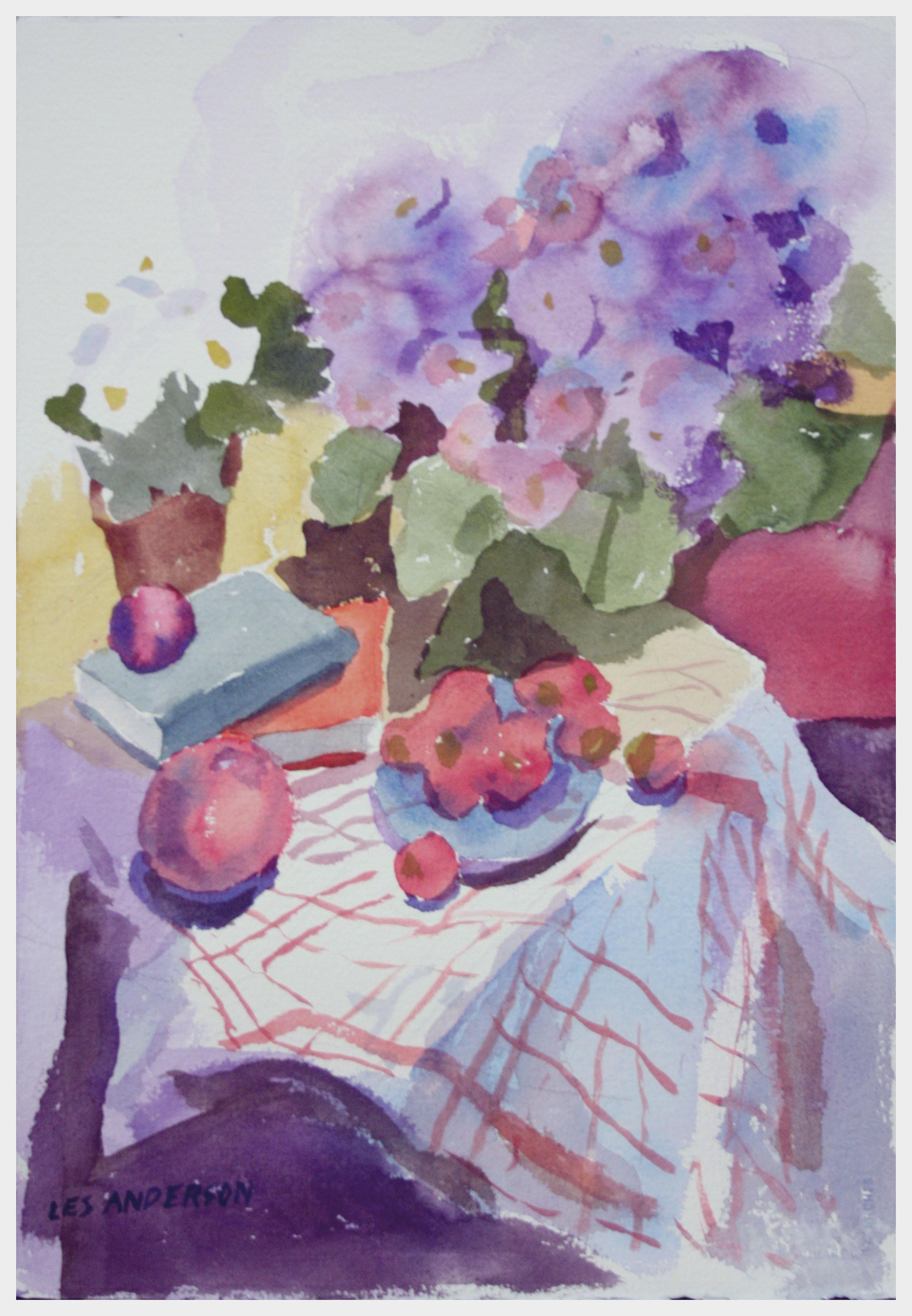Items Similar to Hillside Lake Watercolor Landscape
Want more images or videos?
Request additional images or videos from the seller
1 of 10
Les AndersonHillside Lake Watercolor Landscapec.1980
c.1980
About the Item
Colorful watercolor landscape of a lake surrounded by mountains by California artist Les (Leslie Luverne) Anderson (American, 1928-2009). From the estate of Les Anderson in Monterey, California. Unframed. Signed "Les Anderson" lower left. Unframed. Image size: 15"H x 20"W
Les Anderson owned and operated the Bear Flag Gallery in San Juan Bautista, California for many years. He is known for his plein air watercolor paintings and abstracts. Les studied at the Minneapolis School of Art and the Art Center at Los Angeles. From the estate of Les Anderson in Monterey, California.
- Creator:Les Anderson (1928 - 2009, American)
- Creation Year:c.1980
- Dimensions:Height: 15 in (38.1 cm)Width: 20 in (50.8 cm)Depth: 0.1 in (2.54 mm)
- Medium:
- Movement & Style:
- Period:
- Condition:
- Gallery Location:Soquel, CA
- Reference Number:
About the Seller
5.0
Platinum Seller
These expertly vetted sellers are 1stDibs' most experienced sellers and are rated highest by our customers.
Established in 1986
1stDibs seller since 2014
2,513 sales on 1stDibs
Typical response time: <1 hour
- ShippingRetrieving quote...Ships From: Soquel, CA
- Return PolicyA return for this item may be initiated within 14 days of delivery.
More From This SellerView All
- Whalers Shack on the Northern California Coast - Watercolor SeascapeLocated in Soquel, CASerene depiction of a Whaling shack circa 1900 near Davenport, California attributed to Lillian Josephine (Dake) Heath (19th century). Monogram on Verso "J. H. 1900". Dated and initialed on verso "J. H. Feb. 1900" Presented in a new white mat with foam core backing. Mat size: 14"H x 18"W Paper size: 9.25"H x 13.25"W Lillian Heath was one of the Jolly Daubers at the turn of the 19th-century and as a young student, married the senior artist and instructor, Frank Heath...Category
Early 1900s American Impressionist Landscape Drawings and Watercolors
MaterialsWatercolor, Archival Paper
- Prague Villa LandscapeBy James Russell WilliamsLocated in Soquel, CALovely watercolor of an ivy covered villa near Prague, Czech Republic by J. R. Williams (American, 1935 - 2006). Signed by the artist left margin. Presented in a painted black and gold frame. Repair to paper tear, upper center. Image, 21"H x 14.19"W. James Russell “J. R.” Williams was a highly regarded Aptos, California watercolorist...Category
Early 2000s American Impressionist Landscape Drawings and Watercolors
MaterialsWatercolor, Archival Paper
- Lake & Mountains Watercolor LandscapeBy Les AndersonLocated in Soquel, CAColorful watercolor landscape of a lake surrounded by mountains by California artist Les (Leslie Luverne) Anderson (American, 1928-2009). From the estate of Les Anderson in Monterey,...Category
Late 20th Century American Impressionist Landscape Drawings and Watercolors
MaterialsWatercolor, Archival Paper
- Countryside Hills and Cows LandscapeBy Les AndersonLocated in Soquel, CAColorful watercolor of countryside hills with cows (Leslie Luverne) Anderson (American, 1928-2009). Signed "Les Anderson" bottom left. Unframed. Image size: 16"H x 23"W Les Anderso...Category
Late 20th Century American Impressionist Landscape Drawings and Watercolors
MaterialsWatercolor, Archival Paper
- Primroses and Fruit Still LifeBy Les AndersonLocated in Soquel, CAVibrant watercolor still life of primroses and fruit by Les (Leslie Luverne) Anderson (American, 1928-2009). Signed "Les Anderson" bottom left. Unframed. Image size: 15"H x 23"W Le...Category
Late 20th Century American Impressionist Landscape Drawings and Watercolors
MaterialsWatercolor, Archival Paper
- New Brighton Eucalyptus LandscapeBy Les AndersonLocated in Soquel, CABeautiful watercolor of eucalyptus along New Brighton beach by Les (Leslie Luverne) Anderson (American, 1928-2009). From the estate of Les Anderson in Mon...Category
Late 20th Century American Impressionist Landscape Drawings and Watercolors
MaterialsWatercolor, Archival Paper
You May Also Like
- “The Mountains of St. Maurice”By Dodge MacknightLocated in Southampton, NYOriginal watercolor on archival paper of the mountains of Saint Maurice in Switzerland by the well known American artist, Dodge MacKnight. Signed lower left and titled and dated 189...Category
1890s American Impressionist Landscape Drawings and Watercolors
MaterialsWatercolor, Archival Paper
- 59th Street Bridge, Pennsylvania Impressionist Watercolor CityscapeBy Walter Emerson BaumLocated in Doylestown, PA"59th Street Bridge" is a 22" x 30" watercolor on paper cityscape of the Brooklyn Bridge and city skyline, painted by Pennsylvania Impressionist and...Category
1940s American Impressionist Landscape Drawings and Watercolors
MaterialsWatercolor, Archival Paper
- Pennsylvania Farmhouse, American Impressionist Landscape, Watercolor on PaperBy Albert Van Nesse GreeneLocated in Doylestown, PA"Pennsylvania Farmhouse" is a beautiful spring landscape with rolling hills and countryside farmhouses. The watercolor on paper is painted by American Impressionist Albert Van Nesse Greene. The painting is a 14" x 19" watercolor on paper, matted, framed under glass, and signed "A V Greene...Category
Early 20th Century American Impressionist Landscape Drawings and Waterco...
MaterialsWatercolor, Archival Paper
- The Rapids (Maine)By John WhorfLocated in Provincetown, MAJohn Whorf, born in 1903, was a talented, opinionated artist who achieved great success at a young age. Encouraged by his artistic father, Whorf studied briefly during his early te...Category
Early 20th Century American Impressionist Landscape Drawings and Waterco...
MaterialsPaper, Watercolor
- "Untitled 1, " Watercolor PaintingLocated in Denver, COClyde Steadman's "Untitled 1" is an original, handmade watercolor painting that depicts an urban landscape with human silhouettes.Category
2010s American Impressionist Figurative Drawings and Watercolors
MaterialsPaper, Watercolor
- "Train Station, " Max Kuehne, Industrial City Scene, American ImpressionismBy Max KuehneLocated in New York, NYMax Kuehne (1880 - 1968) Train Station, circa 1910 Watercolor on paper 8 1/4 x 10 1/4 inches Signed lower right Provenance: Private Collection, Illinois Max Kuehne was born in Halle, Germany on November 7, 1880. During his adolescence the family immigrated to America and settled in Flushing, New York. As a young man, Max was active in rowing events, bicycle racing, swimming and sailing. After experimenting with various occupations, Kuehne decided to study art, which led him to William Merritt Chase's famous school in New York; he was trained by Chase himself, then by Kenneth Hayes Miller. Chase was at the peak of his career, and his portraits were especially in demand. Kuehne would have profited from Chase's invaluable lessons in technique, as well as his inspirational personality. Miller, only four years older than Kuehne, was another of the many artists to benefit from Chase's teachings. Even though Miller still would have been under the spell of Chase upon Kuehne's arrival, he was already experimenting with an aestheticism that went beyond Chase's realism and virtuosity of the brush. Later Miller developed a style dependent upon volumetric figures that recall Italian Renaissance prototypes. Kuehne moved from Miller to Robert Henri in 1909. Rockwell Kent, who also studied under Chase, Miller, and Henri, expressed what he felt were their respective contributions: "As Chase had taught us to use our eyes, and Henri to enlist our hearts, Miller called on us to use our heads." (Rockwell Kent, It's Me O Lord: The Autobiography of Rockwell Kent. New York: Dodd, Mead and Co., 1955, p. 83). Henri prompted Kuehne to search out the unvarnished realities of urban living; a notable portion of Henri's stylistic formula was incorporated into his work. Having received such a thorough foundation in art, Kuehne spent a year in Europe's major art museums to study techniques of the old masters. His son Richard named Ernest Lawson as one of Max Kuehne's European traveling companions. In 1911 Kuehne moved to New York where he maintained a studio and painted everyday scenes around him, using the rather Manet-like, dark palette of Henri. A trip to Gloucester during the following summer engendered a brighter palette. In the words of Gallatin (1924, p. 60), during that summer Kuehne "executed some of his most successful pictures, paintings full of sunlight . . . revealing the fact that he was becoming a colorist of considerable distinction." Kuehne was away in England the year of the Armory Show (1913), where he worked on powerful, painterly seascapes on the rocky shores of Cornwall. Possibly inspired by Henri - who had discovered Madrid in 1900 then took classes there in 1906, 1908 and 1912 - Kuehne visited Spain in 1914; in all, he would spend three years there, maintaining a studio in Granada. He developed his own impressionism and a greater simplicity while in Spain, under the influence of the brilliant Mediterranean light. George Bellows convinced Kuehne to spend the summer of 1919 in Rockport, Maine (near Camden). The influence of Bellows was more than casual; he would have intensified Kuehne's commitment to paint life "in the raw" around him. After another brief trip to Spain in 1920, Kuehne went to the other Rockport (Cape Ann, Massachusetts) where he was accepted as a member of the vigorous art colony, spearheaded by Aldro T. Hibbard. Rockport's picturesque ambiance fulfilled the needs of an artist-sailor: as a writer in the Gloucester Daily Times explained, "Max Kuehne came to Rockport to paint, but he stayed to sail." The 1920s was a boom decade for Cape Ann, as it was for the rest of the nation. Kuehne's studio in Rockport was formerly occupied by Jonas Lie. Kuehne spent the summer of 1923 in Paris, where in July, André Breton started a brawl as the curtain went up on a play by his rival Tristan Tzara; the event signified the demise of the Dada movement. Kuehne could not relate to this avant-garde art but was apparently influenced by more traditional painters — the Fauves, Nabis, and painters such as Bonnard. Gallatin perceived a looser handling and more brilliant color in the pictures Kuehne brought back to the States in the fall. In 1926, Kuehne won the First Honorable Mention at the Carnegie Institute, and he re-exhibited there, for example, in 1937 (Before the Wind). Besides painting, Kuehne did sculpture, decorative screens, and furniture work with carved and gilded molding. In addition, he designed and carved his own frames, and John Taylor Adams encouraged Kuehne to execute etchings. Through his talents in all these media he was able to survive the Depression, and during the 1940s and 1950s these activities almost eclipsed his easel painting. In later years, Kuehne's landscapes and still-lifes show the influence of Cézanne and Bonnard, and his style changed radically. Max Kuehne died in 1968. He exhibited his work at the National Academy of Design, the Art Institute of Chicago, the Carnegie Institute in Pittsburgh, the Memorial Art Gallery of the University of Rochester, and in various New York City galleries. Kuehne's works are in the following public collections: the Detroit Institute of Arts (Marine Headland), the Whitney Museum (Diamond Hill...Category
1910s American Impressionist Landscape Drawings and Watercolors
MaterialsPaper, Watercolor
Recently Viewed
View AllMore Ways To Browse
Lake In California
Vintage At The Lakes
Vintage Lake Signs
Artist Anderson
Monterey California
Lake And Mountain Landscape
California Bear
Los Angeles Lakers
Hillside Painting
Mountain Landscape Colorful
Hillside Landscape
C Anderson
California Flag
Used California Flag
Flag Of California
American Flag California
American Flag Vintage Images
San Juan Landscape
